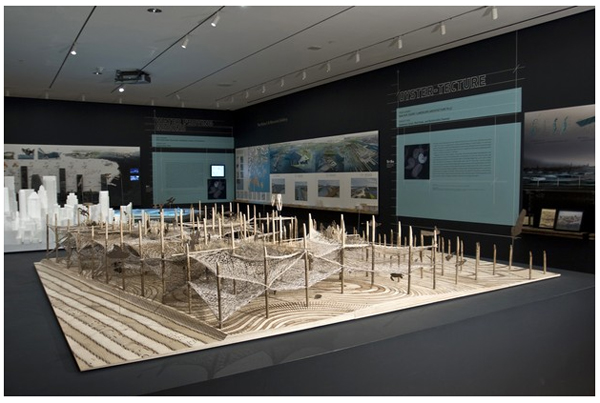The Rising Currents exhibition at MoMA in 2010 featured one of our recent favorite projects here at Animal Architecture, led by Kate Orff of SCAPE and a team of ecologists, high school students, and oyster farmers. Oyster-Tecture is sited near the Red Hook section of New York’s harbor and the Gowanus Canal (deemed a Superfund site as of March 2010), and is inspired by current local restoration efforts and the life cycle of the oyster. The team describes the project’s design below:
This living reef is constructed from a field of piles and a woven web of “fuzzy rope” that supports oyster growth and builds a rich three-dimensional landscape mosaic. A watery regional park for the New York Harbor emerges that prefigures the city’s return to the waterfront in the next century. The reef attenuates waves and cleans millions of gallons of Harbor water through harnessing the biotic processes of oysters, mussels, and eelgrass, and enables neighborhood fabrics that welcome the water to develop further inland.
Oysters are amazingly adept creatures at adapting to changes in harbor makeup, by being biofiltrators, storm surge devices, and wave attenuators. A single oyster can filtrate up to 50 gallons of water in a day! Though the proposed New York oysters would not be able to be consumed by residents until 2050, Orff’s design harnesses the natural biological power of these mollusks (not to mention their deliciousness as well).
The soft infrastructure built by the artificial ecology of the oyster reef offshore is aimed to create a new recreational space for the city, allowing people to relate to the harbor in new or forgotten ways (i.e. back in those halcyon days of fishing for oysters along the briny New World shore). The new ecologies would help educate visitors, foster spaces of activity otherwise unavailable in New York, and give other animals (such as horseshoe crabs and migratory birds) revived nesting areas.
It’s unclear just how likely Orff’s project will be executed but given its broad multi-species appeal we would like to think that it would be an obvious win-win and get fast-tracked into reality. Aside from the obvious benefits of increased eco-diversity there’s much that we, and especially New Yorkers (being so close to the impending rising sea-levels…), could learn from a rich littoral environment.
To quote Orff in her TED talk, “for the next watery century, get your Tevas on!”
-Ned Dodington and Lauren Elachi worked on this post.









